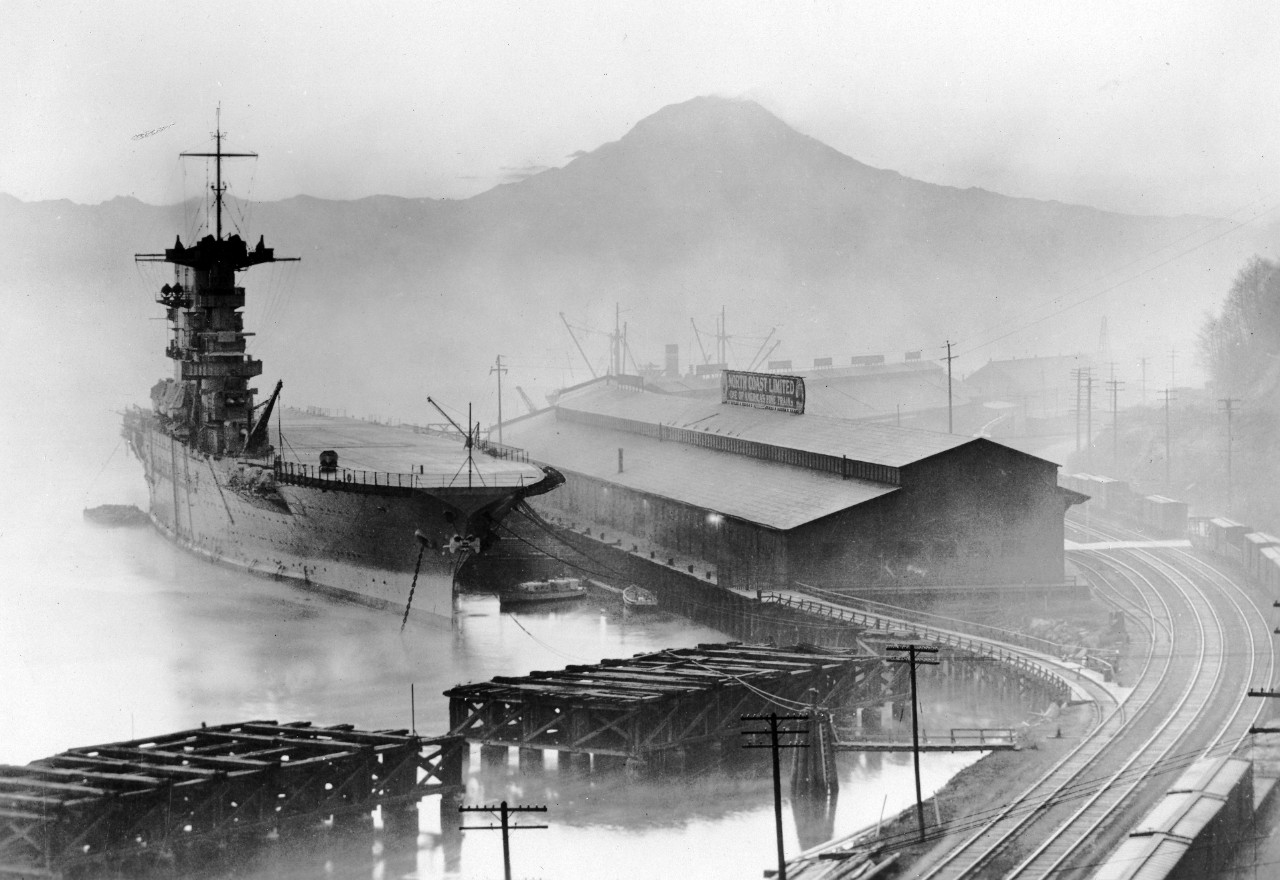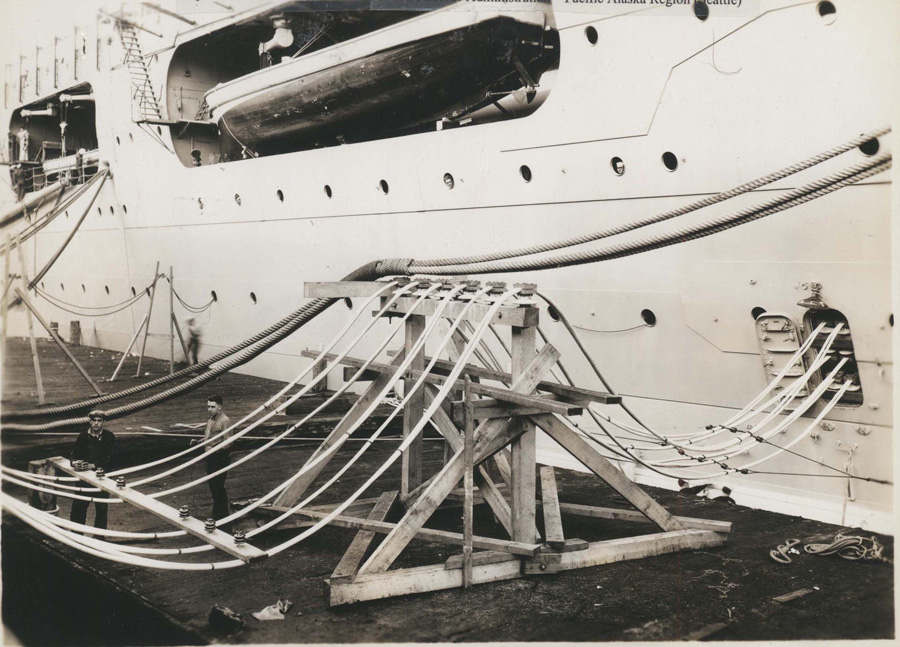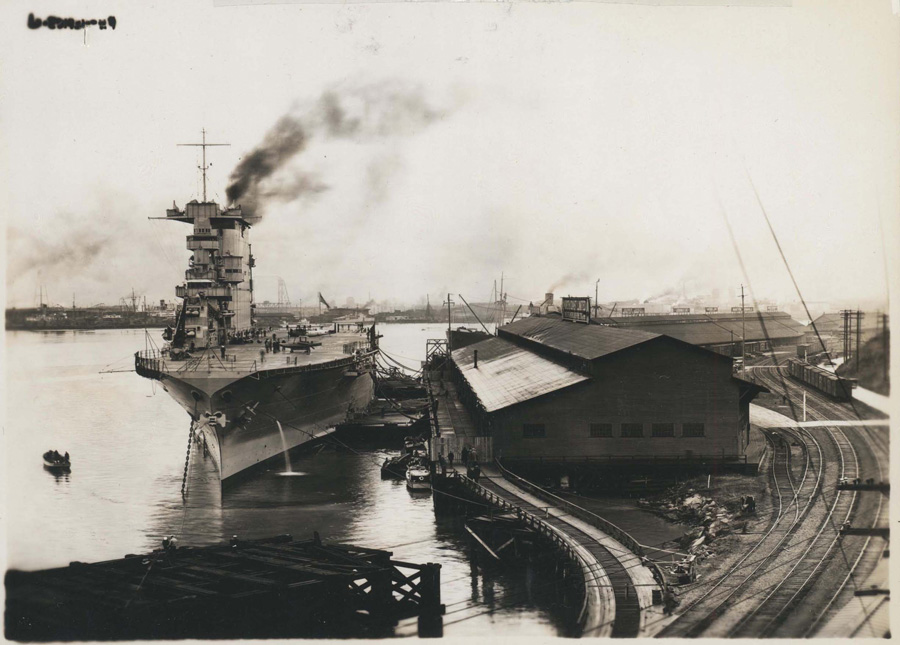
While this site generally focuses on the period of the Second World War, in my current research books I encountered one of the ships that I’d written about before—the USS Lexington—in a fascinating pre-war anecdote.
The USS Lexington (CV-2) was one of the very first U.S. air craft carriers, initially laid down as a battle cruiser and later converted. She was the fourth U.S. Navy ship to bear her name, and was launched in 1925, then commissioned in 1927.
In 1929, the U.S. stock market crashed and the Great Depression began. On top of the economic disaster, the city of Tacoma, Washington faced a serious power shortage. The city depended on hydro-electric power from Lake Cushman and the Nisqually River. Unfortunately, unusual cold weather and a drought the previous fall meant that there simply wasn’t enough build up of water behind the dams.
The solution? Bring in an aircraft carrier!

At Tacoma’s Baker Dock, the Lexington was hooked up to the city’s electrical grid on December 15, 1929. For twelve hours each day, she generated and transmitted about 20,000 kilowatts of power.

The calendar page turned, and by January 16, 1930, enough water had built up behind the dams to serve Tacoma’s needs. Crisis averted, Lexington returned to her regular duties.
The following year Lexington was called upon for another mission of mercy—transporting disaster relief supplies and personnel to the aftermath of a terrible earthquake and fire in Managua, Nicaragua.
On December 7, 1941, Lexington was absent from Pearl Harbor, busy transporting Marine planes to Midway Island. She was active in the Pacific until May 8th, when she was scuttled after serious damage the Battle of the Coral Sea.

The wreck of the Lexington was discovered in 2018. For more information on the discovery, you can check out this article from the Naval History and Heritage Command.
If you’d like more information on the Lexington’s history, here is the ship’s entry in the Naval History and Heritage Command site.
Thank you so much for stopping by today. Have you encountered any interesting history in unexpected places? I’d love to hear your stories, too!



Had never known that the USS Lexington had been an urban power generator! Thanks for sharing this interesting tid-bit from history.
LikeLiked by 1 person
It’s not something I even considered carriers capable of!
Thanks for stopping by.
LikeLike
What a story! Hope you’ll let me share it!
LikeLiked by 2 people
Of course! Thanks, Joy.
LikeLike
A neat bit of history, Anne. It reminds me of the naval hospital ships doing backup duty during Covid. –Curt
LikeLiked by 3 people
Thanks, Curt. Oh yes! I never heard if they ended up needing to be put into use but I heard quite a bit about them being in place if needed, which is great.
LikeLiked by 1 person
This is such a great story. The Lexington Class (Lexington and Saratoga) used a unique (I think?) turbo-electric power plant that made them ideally suited to this sort of use. It proved troublesome in wartime (the Saratoga survived the War, but was always maintenance intensive) but was a huge boon here.
LikeLiked by 2 people
Thanks! Oh, interesting! I’ve been reading up on the wartime in Puget Sound, particularly at the Navy Yard- apparently Saratoga spent enough time at the Yard to get the nickname “Sara” :).
LikeLiked by 1 person
Yeah, it’s probably not ideal when repair crews are on a first name basis with your ship….
LikeLiked by 1 person
I remember reading when the USS Lexington was found.
LikeLiked by 1 person
I thought it was interesting that it was such a recent discovery!
LikeLike
Absolutely fascinating, Anne! Btw – do you know about WW2 database as a source for photos?
LikeLiked by 1 person
Thanks so much!
No, I don’t think I’ve come across WW2 database- or at least haven’t used it. It sounds like something to check out- thanks!
LikeLike
I never knew that part of her history! Thank you, Anne.
LikeLiked by 1 person
Isn’t it an interesting story? I’m glad you enjoyed it too- thanks for stopping by, GP!
LikeLiked by 1 person
What an amazing episode! I’ll have to tell Himself in the morning – thank you so much for this fascinating article, Anne:)).
LikeLiked by 1 person
Thank you- I hope he enjoys it! 🙂
LikeLiked by 1 person
I’m actually impressed that you managed to get so many relevant photos, because it’s not as if there are lots of ready places to source these. Interesting as always. Thanks for this post!
LikeLiked by 1 person
Thank you! I made a great contact with a museum curator at a Naval museum in the Tacoma area- she pointed me in the right direction!
LikeLike
Interesting article Anne Clare. The way things are going you may need more aircraft carriers / power stations.We are in the same boat…..
LikeLiked by 1 person
Thank you, Dennis, and thanks for stopping by!
Yes, these are interesting times…
LikeLiked by 1 person
I forgot they had found it! And Lexington’s story should remind us all that aircraft carriers–and other military vehicles–are NOT all about war, but protecting others in times of peace and need. xxxxxx
LikeLiked by 3 people
Exactly xxxxx
LikeLiked by 2 people